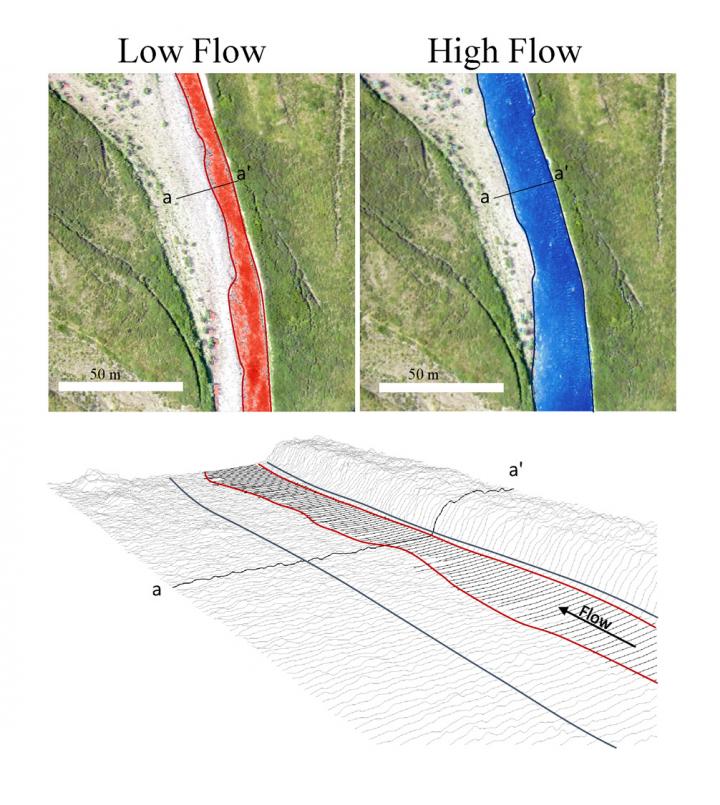Aerial imagery gives insight into water trends

USU researchers published a study that shows how high resolution aerial imagery can be used to estimate flows along smaller rivers and streams. Credit: USU
Tyler King and Bethany Neilson, researchers at Utah State University, have developed a new method to estimate river discharge using aerial imagery gathered from helicopters and drones. Their new study, published Feb. 7 in Water Resources Research, found that aerial imaging can be just as accurate as older, more expensive field methods in some cases.
These alternative methods for monitoring water resources are necessary to continue meeting global water demands while simultaneously easing the impacts of floods and droughts.
“We are headed into uncharted territory as climate change alters water supply and population growth increases demand,” said Tyler King, a PhD candidate and co-author of the study. “In the face of these challenges, scientists, engineers and managers around the world are asked to perform the increasingly difficult task of managing water resources with less and less information.”
There are a limited and dwindling number of locations where river discharge is measured directly at gauging stations. Establishing and maintaining these stations is expensive and time consuming. As a result, preference is often given to large rivers of significant economic and social importance.
Additionally, other remote sensing methods have been developed, but rely on relatively coarse data collected by satellites and, as such, also focus on the larger rivers of the world. As a result, scientists lack a complete view of what is happening in smaller river basins, leaving limited understanding of the processes controlling river water quantity and quality.
King and Neilson's approach aims to fill this data gap by using high resolution aerial imagery to estimate flows at many locations along smaller rivers and streams. This complements both traditional gauging station networks that are tied to a limited number of specific locations along river networks and satellite based remote sensing methods that are used to estimate flows in larger rivers.
Their basic approach uses a unique combination of image processing techniques and hydraulic modeling that limits the amount of data required to estimate river discharge. Their method overlaps aerial images to produce three-dimensional digital elevation models of the river channels.
This information is then used within a hydraulic model to approximate the relationship between river discharge and river width. Once these models are built, any following observations of river width — including satellite imagery, aerial imagery or ground observations — can be used to estimate river discharge.
“Remote sensing methods like these can significantly improve our ability to understand hydrologic responses to a changing climate in small, ungauged watersheds around the world,” said Neilson, an associate professor at USU and co-author of the study.
###
Direct Researcher Contact: Bethany Neilson – Associate Professor, Utah State University | bethany.neilson@usu.edu | office: (435) 797-7369
Tyler King – PhD Candidate, Utah State University | tylerking@aggiemail.usu.edu | office: (435) 797-0748
For additional media assistance contact: Grace Michaelson – USU College of Engineering | grace.michaelson@usu.edu | office: (435) 797-8170 | mobile: (702) 524-1070 | engineering.usu.edu | @engineeringUSU
Media Contact
All latest news from the category: Earth Sciences
Earth Sciences (also referred to as Geosciences), which deals with basic issues surrounding our planet, plays a vital role in the area of energy and raw materials supply.
Earth Sciences comprises subjects such as geology, geography, geological informatics, paleontology, mineralogy, petrography, crystallography, geophysics, geodesy, glaciology, cartography, photogrammetry, meteorology and seismology, early-warning systems, earthquake research and polar research.
Newest articles

High-energy-density aqueous battery based on halogen multi-electron transfer
Traditional non-aqueous lithium-ion batteries have a high energy density, but their safety is compromised due to the flammable organic electrolytes they utilize. Aqueous batteries use water as the solvent for…

First-ever combined heart pump and pig kidney transplant
…gives new hope to patient with terminal illness. Surgeons at NYU Langone Health performed the first-ever combined mechanical heart pump and gene-edited pig kidney transplant surgery in a 54-year-old woman…

Biophysics: Testing how well biomarkers work
LMU researchers have developed a method to determine how reliably target proteins can be labeled using super-resolution fluorescence microscopy. Modern microscopy techniques make it possible to examine the inner workings…





















